The genus Fraxinus, a family of deciduous trees, includes the olive and the ash tree. The trees primarily grow in the northern hemisphere, and 18 ash species are found in the United States. Five predominate the market for lumber cuts and ornamental tree plantings. Most ash trees are small to medium in height, although some can grow as large as 60 to 125 feet.
Ash trees (Fraxinus spp.) are fast-growing trees with branches that grow opposite one another, instead of alternately, and have compound leaves made up of leaflets. Ashes are notorious for developing a weak canopy that can break easily in high winds. They are very adaptable, however, and can thrive in a wide range of soils. Ash trees are. characterized with typically pale or dark gray bark and dark green foliage, often closely resemble one another and can be difficult to differentiate. Here are some of the major ash trees you need to know:
- Black Ash (Fraxinus nigra)
- Green Ash (Fraxinus pennsylvanica)
- White Ash (Fraxinus americana)
- Blue Ash (Fraxinus quadrangulata)
- California Ash (Fraxinus dipetala)
- Carolina Ash (Fraxinus caroliniana)
- European Ash (Fraxinus excelsior)
- Gregg’s Ash (Fraxinus greggii)
- Manna Ash (Fraxinus ornus)
- Narrow Leaf Ash (Fraxinus angustifolia)
- Pumpkin Ash (Fraxinus profunda)
- Velvet Ash (Fraxinus velutina)
- Manchurian Ash (Fraxinus mandshurica)
- Oregon Ash (Fraxinus latifolia)
- Chinese Ash (Fraxinus chinensis)
- Shamel Ash (Fraxinus uhdei)
- Autumn Purple (Fraxinus americana Autumn Purple)
- Texas Ash (Fraxinus albicans)
- Berrinda Ash (Fraxinus velutina ‘Berrinda’)
- Raywood ash (Fraxinus angustifolia “Raywood”)
Black Ash

Black ash is a medium-sized deciduous tree reaching 15–20 m (exceptionally 26 m) tall with a trunk up to 24 inches diameter, The bark is grey, thick and corky even on young trees, becoming scaly and fissured with age. The winter buds are dark brown to blackish, with a velvety texture. The leaves on this ash tree are compound, each including seven to eleven toothed leaflets. The leaflets are not stalked, and they die and fall to the ground in autumn. The leaves are pinnately compound whereas the flowers are produced in spring shortly before the new leaves, in loose panicles; they are inconspicuous with no petals, and are wind-pollinated.
Green Ash

The green ash has also been called red ash is a deciduous tree that can reach a height of about 60 feet with a spread of 45 feet. The bark is smooth and gray on young trees, becoming thick and fissured with age. The winter buds are reddish-brown, with a velvety texture. Upright main branches bear twigs which droop toward the ground before bending upward at their tips much like basswood. The glossy dark green foliage will turn yellow in the fall. With the widest native range of any of the ashes, growing from Nova Scotia to Alberta in Canada and extending south through the United States to Florida and Texas, it grows naturally along riparian zones and in other watery areas, such as floodplains and sloughs.
Also Read: Different Types of Hickory Trees For Your Home
White Ash
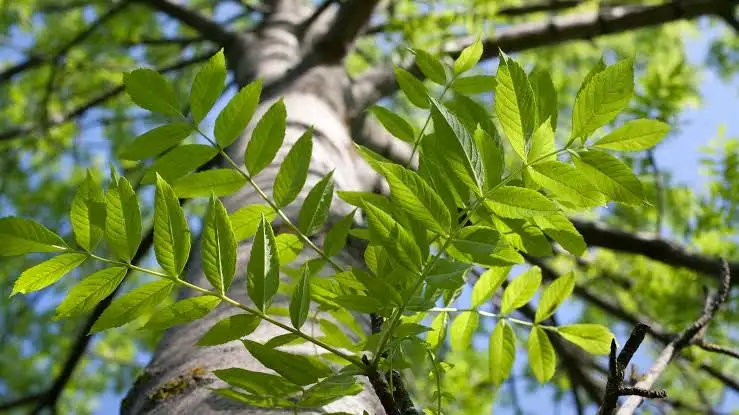
White ash also called Biltmore ash or Biltmore white ash usually grows to 65-100 feet tall and has branches stemming equally around, which makes the tree develop into a rounded shape at maturity. Its leaves are dark green, opposite, pinnately compound with seven leaflets, pinnately veined, with teeth at the pointed tips. The fruit produced by this tree is called a samara, which is a winged fruit a little over one inch long that hangs in clusters and can remain on the tree for the entire winter. White Ash shades many parks, large yards, and other sizable areas and provides exquisite fall color ranging from yellow to deep purple and maroon. Beyond it’s landscape, the wood of white ash trees is used to make a range of sporting equipment, including oars, hockey sticks, tennis rackets and the iconic Louisville Slugger baseball bats as well as interior floors, furniture and the handles on many types of tools.
Blue Ash
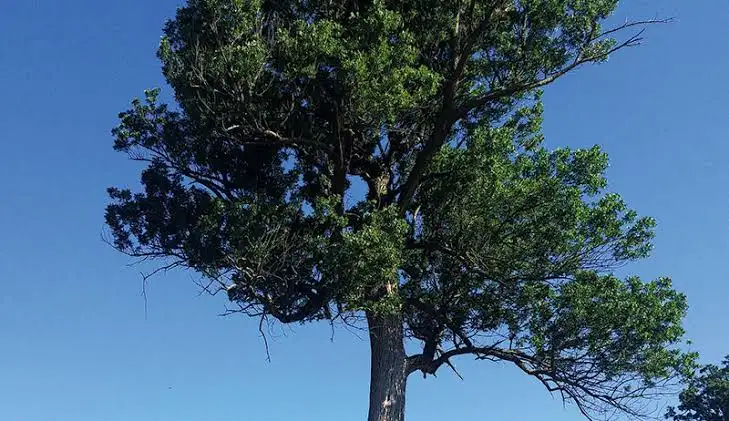
The blue ash is a medium-sized tree that can be identified by its squarish twigs, which is the origin of the botanical name, four-cornered ash. The size of the blue ash, 50 to 75 feet, makes it a great shade tree. Leaves are opposite and compound, with 5-9 short-stalked, ovate leaflets. Flowers are bisexual, small, and numerous, emerging as purplish-green. The flowers develop into numerous samaras, which hang in clusters and disperse in the wind. The bark is grayish on mature trees, and separates into irregular plates. But blue ash trees are getting harder to find. Sadly, the tree is now declared endangered due to the emerald ash borer (EAB), which plagues all ash trees in North America.
California Ash

The California ash also referred to as two-petal ash features compound leaves that are 6 to 9 inches long and have five to nine leaflets apiece. blue ash is a medium to large tree, averaging 40 to 60 feet in height. Some specimens can grow as large as 120 feet tall, with a trunk diameter of 3 feet. California ash has samaras shaped like paddles. Mature trees are slightly pyramidal with a rounded crown. The tree gets its name from a sap from the fact that the are exclusively found in California. The flowers have two white lobe-shaped petals 2.5–4 mm long, and are sweetly scented, hanging in fluffy clusters; unlike many ashes, they are bisexual, not dioecious.
Also Read: Major Types of Walnut Trees For Landscaping
European Ash

The European ash can reach up to 115 feet tall and have a spread of up to 60. It can be distinguished from other ash trees by almost black buds. It usually has a much wider spread than other ash trees, and the European ash has a dark green leaf that is made up of seven to 13 thirteen leaflets in an opposing pattern, which turn rich shades of yellow in the fall. After dropping to the ground, the attractive silvery-brown bark, ridged and furrowed into diamond-shaped patterns, is revealed, providing winter interest. In mid-late spring, purplish male and female flowers appear on separate trees. European Ash is an important precious wood tree. It makes a splendid shade tree or specimen tree for a large landscape.
Gregg’s Ash
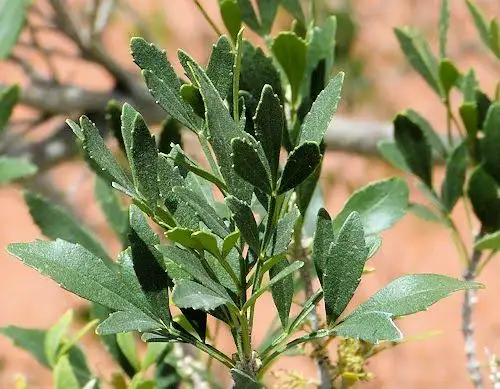
Gregg ash is an outstanding small tree found on rocky limestone slopes and canyons and more prevalently in dry creek beds and washes in southern southwest Texas. Gregg’s ash has nearly evergreen leaves that are less than 2 in. long. It is a shrub or sometimes small tree to 19 ft. in height. Smooth, thin, gray bark; slender branches; and pinnate, dark-green, leathery leaves characterize the plant. The perfect male or female flowers can occur on different trees, the same tree, or even in the same cluster.
Manna Ash

The manna ash or flowering Ash is a pretty, medium-sized, deciduous tree with a short trunk and a dense oval to almost round, irregular crown. In late spring, fragrant, showy white flower panicles appear above the foliage. They are followed by clusters of winged seeds that ripen in fall and may persist on the tree throughout winter. The foliage of compound pinnate, mat blue-green leaves contains 5-9 leaflets which turn sometimes rich shades of yellow-burgundy to red-purple in the fall. After dropping to the ground, the attractive smooth, silver bark is revealed, providing winter interest. Flowering Ash is a splendid shade tree or specimen tree for a large landscape.
Also Read: Major Types of Poplar Trees For Your Yard
Narrow Leaf Ash
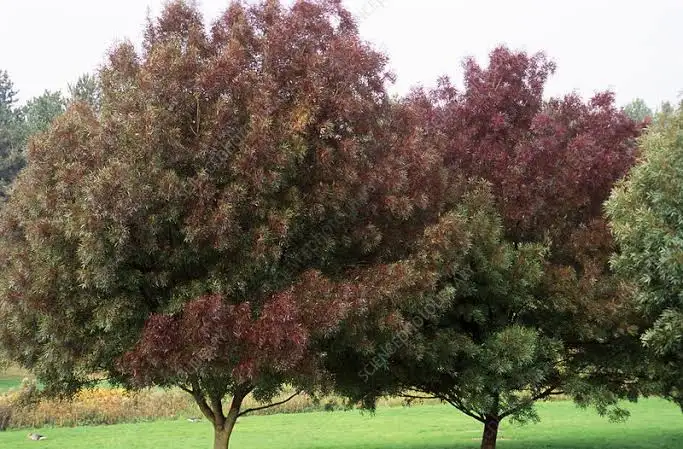
Narrow Leaf Ash is a medium-sized tree growing to 20–30 m tall with a trunk up to 1.5 m diameter. The bark is smooth and pale grey on young trees, becoming square-cracked and knobbly on old trees. The buds are pale brown, which readily distinguishes it from the related European ash (black buds) even in winter. The leaves are in opposite pairs or whorls of three, pinnate, with the leaflets being distinctively slender. The flowers are produced in inflorescences which can be male, hermaphrodite or mixed male and hermaphrodite.
Pumpkin Ash

Pumpkin ash is a large tree, reaching heights of up to 130 feet, with a trunk diameter of up to 5 feet on sites with excellent growing conditions. The tree grows best in areas where there is standing water at the surface well into the growing season. In these areas, the tree often develops a swollen or pumpkin-shaped base. The crown is broadly rounded, with thick branches. The pumpkin ash is a rare tree that, like other native trees in the genus Fraxinus, has become even more rare in recent years due to the emerald ash borer. It is most commonly found in wet swampy areas, with a habit of growing in deep standing water.
Velvet Ash
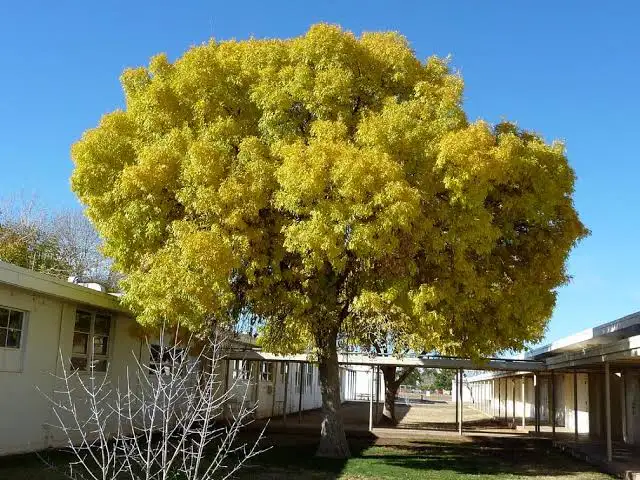
The velvet ash, Arizona ash or Modesto ash is small deciduous tree growing to 10 m tall, with a trunk up to 30 cm diameter and with open, rounded crown of spreading branches and leaflets quite variable in shape and hairiness. Spreading branches form a rounded crown. The bark is rough gray-brown and fissured, and the shoots are velvety-downy. The flowers are produced in small clusters in early spring; it is dioecious, with male and female flowers on separate trees. Modesto Ash is a rapidly growing, cultivated variety, widely planted as a street tree in dry areas (including alkaline soils) in California and the Southwest.
Also Read: Different Types of Birch Trees
Manchurian Ash

Manchurian ash is a medium-sized tree with a dense, oval to rounded crown. Manchurian is native to wooded slopes and open valleys of northeast Asia and Japan and is similar in appearance to Fraxinus nigra (black ash). Leaves are pinnately compound that grow to 10-15 inched long. Each leaf has up to 11 coarsely-toothed, lance-shaped leaflets that are between 3-5 inches long. The leaflets are matte green above and downy on both sides. Leaves are an attractive yellow in the fall. Non-showy, greenish-yellow flowers in compact panicles begin to bloom in spring before the leaves emerge. This tree is sometimes dioecious. Female flowers give way to winged samaras which mature in August-October in drooping clusters.The seeds are eaten by birds and squirrels.
Oregon Ash

Oregon Ash is a magnificent large tree with a straight trunk and a dense narrow crown. The foliage of compound pinnate, light green leaves contains 5-9 leaflets which turn clear yellow in the fall. The young bark is thin, smooth, and gray-green becoming gray-brown, thick and furrowed with age. In spring, before the leaves emerge, inconspicuous greenish male and female flowers appear in dense, glabrous panicles on separate trees. The female flowers are followed by dense clusters of hanging samaras that ripen in fall. Prized for its beautiful symmetrical shape, rapid growth, and hardiness, Oregon Ash has been widely planted as an ornamental tree and a street tree. It is also excellent for revegetating wet, lowland areas.
Shamel Ash

The shamel ash also referred to as Tropical or Evergreen Ash, is a fast-growing tree that can reach heights of up to 80 feet, with a spread of up to 60 feet. Also known as evergreen ash or tropical ash, it is notable for its showy leaves, which may be up to 11-inches long and lined with up to 9 leaflets. The shamel ash can tolerate brief periods of temperatures as low as 20 degrees Fahrenheit, though it may drop leaves or suffer some branch dieback.
Also Read: Oak Trees For Landscaping Your Home
Autumn Purple Ash

Autumn Purple Ash is a male cultivar of the white ash tree. It is distinguished by reddish-purple fall foliage that begins early and lasts well into the autumn season. The Autumn Purple grows to be 45 to 60 feet tall. Each leaf on a white ash tree consists of seven oval-shaped leaflets that range in length from 2 to 4 inches. The bark on these trees may be yellow-brown or light gray and features deep furrows. White ash trees are dioecious; that means that some individuals are male and others are female. Because they are male trees, Autumn Purples do not bear fruit, which makes them a mess-free landscaping option.
Texas Ash
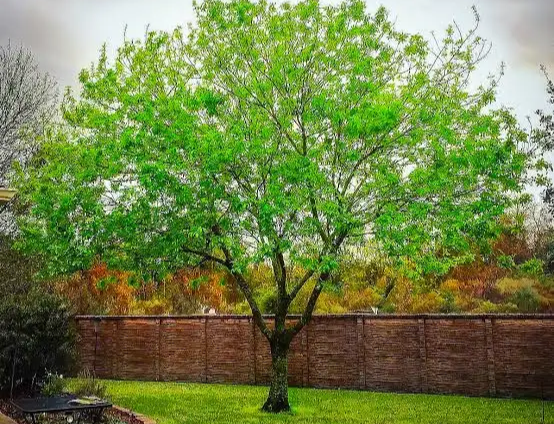
The Texas ash sometimes called the mountain ash, is a slow-growing type of ash tree that generally grows to about 30 feet tall and makes a handsome shade tree for smaller landscapes. The dense branches bear olive green to deep green leaves that turn brilliant shades of orange, gold, purple or red in autumn. Inconspicuous green flowers appear in spring, followed by ornamental pink or red fruit. The tree is tough and durable, requiring minimal maintenance and care so long as it is planted in the proper growing conditions.
Berrinda Ash

The Berrinda ash is a cultivar of Fraxinus veluntina, or the velvet ash. Berrinda is also commonly known as the Arizona ash, as the tree is widely distributed throughout the state. The Berrinda ash reaches a maximum average height of about 35 feet. In its youth, it has a pyramidal shape, but that widens with age until the canopy reaches a maximum average width of about 35 feet. Berrinda features lobed leaves, with either three or five 3-inch-long leaflets. The leaves turn yellow in autumn. The winged seeds can be a problem, as they are messy.
Raywood Ash

The Raywood ash also referred to as Claret Ash has dark green, heavily lobed leaves just like its cousin, the Berrinda ash, but fall foliage is showier: The leaves turn brilliant shades of red and purple. The fine texture of this ash tree’s dark, lustrous leaflets contributes to the whimsy of the neat round canopy. The Raywood ash produces no seeds, so it is not as messy as the Berrinda ash. Raywood Ash is used as a shade and street tree in suburban and urban neighborhoods due to its vigorous growth, and tolerance of pollution and strong winds. In autumn color the deep-green leaves turn a striking wine-red, giving the tree the nickname “Claret Ash.”
Further References
- Facts About Ash Trees: https://www.britannica.com/plant/ash-tree
- Ash Trees Identification: https://csfs.colostate.edu/forest-management/ash-tree-identification/
- How To Identify An Ash Tree: https://www.google.com/amp/s/www.wikihow.com/Identify-an-Ash-Tree%3famp=1?espv=1
- Species of Ash Trees: https://www.thespruce.com/twelve-species-of-ash-trees-3269661
- Ash Tree Varieties: https://www.gardeningknowhow.com/ornamental/trees/ash/ash-tree-varieties.htm